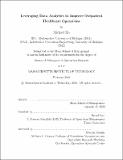| dc.contributor.advisor | Retsef Levi. | en_US |
| dc.contributor.author | Hu, Michael,Ph.D.Massachusetts Institute of Technology. | en_US |
| dc.contributor.other | Massachusetts Institute of Technology. Operations Research Center. | en_US |
| dc.date.accessioned | 2020-10-18T21:16:20Z | |
| dc.date.available | 2020-10-18T21:16:20Z | |
| dc.date.copyright | 2020 | en_US |
| dc.date.issued | 2020 | en_US |
| dc.identifier.uri | https://hdl.handle.net/1721.1/128043 | |
| dc.description | This electronic version was submitted by the student author. The certified thesis is available in the Institute Archives and Special Collections. | en_US |
| dc.description | Thesis: Ph. D., Massachusetts Institute of Technology, Sloan School of Management, Operations Research Center, 2020 | en_US |
| dc.description | Cataloged from student-submitted PDF of thesis. | en_US |
| dc.description | Includes bibliographical references (pages 147-158). | en_US |
| dc.description.abstract | Healthcare reform in the United States has received significant attention from the public, physicians, health administrators, and insurance payors. The important policy discussions surrounding healthcare reform have a wide-reaching impact, and often require quantitative data and analytics to support successful changes. This thesis studies a number of burning healthcare problems and offers actionable insights driven by data and analytics. In Chapter 2, we examine the effect of the EHR phenomenon and how it has fundamentally transformed physicians' work. While these computer systems are designed in part to streamline workflows and increase employee efficiency, physician experiences are often the exact opposite. Instead of having more face-to-face time seeing their patients, physicians are forced to spend the majority of their time completing EHR tasks. | en_US |
| dc.description.abstract | In this chapter, we establish rigorous, quantitative methods for measuring and analyzing this problem to help health systems curb the exploding population of burned out physicians. In Chapter 3, we demonstrate how the methods established in Chapter 2 can also be used to predict physician workload, which may assist in the design of physician compensation models. While health systems are shifting away from fee-for-service payment schemes, alternative payment schemes often encounter significant implementation challenges. There are many open questions that need to be resolved before these new payment schemes can achieve widespread adoption. In this chapter, we address one such question, which involves how to properly risk adjust for different patient populations. We leverage the techniques from Chapter 2 to measure the workload imposed on physicians by individual patients. | en_US |
| dc.description.abstract | This enables us to subsequently develop a risk adjustment model that substantially outperforms existing risk adjustment methods in determining the physician workload associated with managing different patient populations. In Chapter 4, we examine the problem of relaxing hospital capacity. Many hospitals frequently operate close to full-capacity which poses serious safety concerns. Most attempted solutions in this space focus on inpatient interventions such as optimizing patient flow and surgery schedules. In contrast to this, we propose an approach based on changes in the longitudinal care delivered by ambulatory services, specifically for the treatment of heart failure patients. Lastly, in Chapter 5, we develop a new modeling framework for real-time appointment scheduling. | en_US |
| dc.description.abstract | While others have applied existing algorithms from online binpacking to solve this problem, our modeling framework leverages unique aspects of appointment scheduling to further optimize scheduling decisions and reduce resource requirements. In doing so, we demonstrate that our modeling framework generalizes the classical bin-packing framework thereby enabling a potentially larger number of problems to be studied using similar techniques. | en_US |
| dc.description.statementofresponsibility | by Michael Hu. | en_US |
| dc.format.extent | 158 pages | en_US |
| dc.language.iso | eng | en_US |
| dc.publisher | Massachusetts Institute of Technology | en_US |
| dc.rights | MIT theses may be protected by copyright. Please reuse MIT thesis content according to the MIT Libraries Permissions Policy, which is available through the URL provided. | en_US |
| dc.rights.uri | http://dspace.mit.edu/handle/1721.1/7582 | en_US |
| dc.subject | Operations Research Center. | en_US |
| dc.title | Leveraging data analytics to improve outpatient healthcare operations | en_US |
| dc.type | Thesis | en_US |
| dc.description.degree | Ph. D. | en_US |
| dc.contributor.department | Massachusetts Institute of Technology. Operations Research Center | en_US |
| dc.contributor.department | Sloan School of Management | |
| dc.identifier.oclc | 1200117137 | en_US |
| dc.description.collection | Ph.D. Massachusetts Institute of Technology, Sloan School of Management, Operations Research Center | en_US |
| dspace.imported | 2020-10-18T21:16:19Z | en_US |
| mit.thesis.degree | Doctoral | en_US |
| mit.thesis.department | Sloan | en_US |
| mit.thesis.department | OperRes | en_US |
